
Contents





Love Travels Through the Strings of the Violin






The Baekdu Daegan as a
Symbol of Korea
Many countries in the world possess areas of exceptional natural beauty. They are well known, and people travel there to experience this beauty. Most non-Koreans can’t imagine Korea as being mountainous until they come here. It’s true to say that Korea cannot compete with the grand vistas of the Himalaya, Andes, Rockies or many others, but it was always gratifying for me to see my guests leave this peninsula with fond memories of its jagged peaks, twisting trails and warm people. For the people of North and South Korea, their mountains represent much more than that. Recently, those mountains have started to become new symbols of peace and cooperation.
Written & photographed by Roger Shepherd of HIKEKOREA

The Baekdu Daegan, the Spine of Korea
It was the Baekdu Daegan mountain range, stretching across the entire Korean Peninsula, that introduced me to Korea’s mountains and culture. I had stumbled upon the southern section’s 687-km continuous ridge on a visit to South Korea way back in 2007. The following year, I returned and walked it again, this time writing the first ever English guidebook about it. As I walked the crest through the Korean heartland, I was awed by the waves of ridges that rolled around me everywhere. The ridge allowed me to meander through mountain villages, through nine national parks, to Buddhist temples and to ancient shrines. I met local people walking it, too. For them, they told me, it was more than an adventure; a way for them to discover themselves, their identity of what it means to be “Korean,” a pilgrimage. I learned that the Baekdu Daegan stretches all the way from Korea’s highest and holiest peak, Baekdusan Mountain on the border between China and North Korea, and that it wrangled itself all the way southward to the Cheonwangbong Peak atop Jirisan Mountain, some 1,400 kilometers away.
 Korea’s Unification flag is flying. The flag was first used in 1989 at the Inter-Korean Sports Dialogue. It is usually used in international sports games to compete as one team.
Korea’s Unification flag is flying. The flag was first used in 1989 at the Inter-Korean Sports Dialogue. It is usually used in international sports games to compete as one team.
The mountain range then rose again at another of Korea’s sacred peaks, Hallasan on Jeju Island. I was told that this completed the genealogy of mountains that make up Korea. Baekdu the grandfather and Halla the grandmother, and every other peak in between; all members of a large homogenous family of mountains. The Baekdu Daegan a spine that transmits all natural energies along its length and then scatters them out down along its secondary ridges, into the fresh waters of its valleys, and then into the lands, foods and people of Korea. It’s a holistic landscape of man and mountain.
Mountains are seen everywhere in Korea, not just on her arrowhead horizons, but in art and literature, too. Even the opening lines of the national anthems of both North and South Korea praise the holy peak of Baekdusan Mountain.
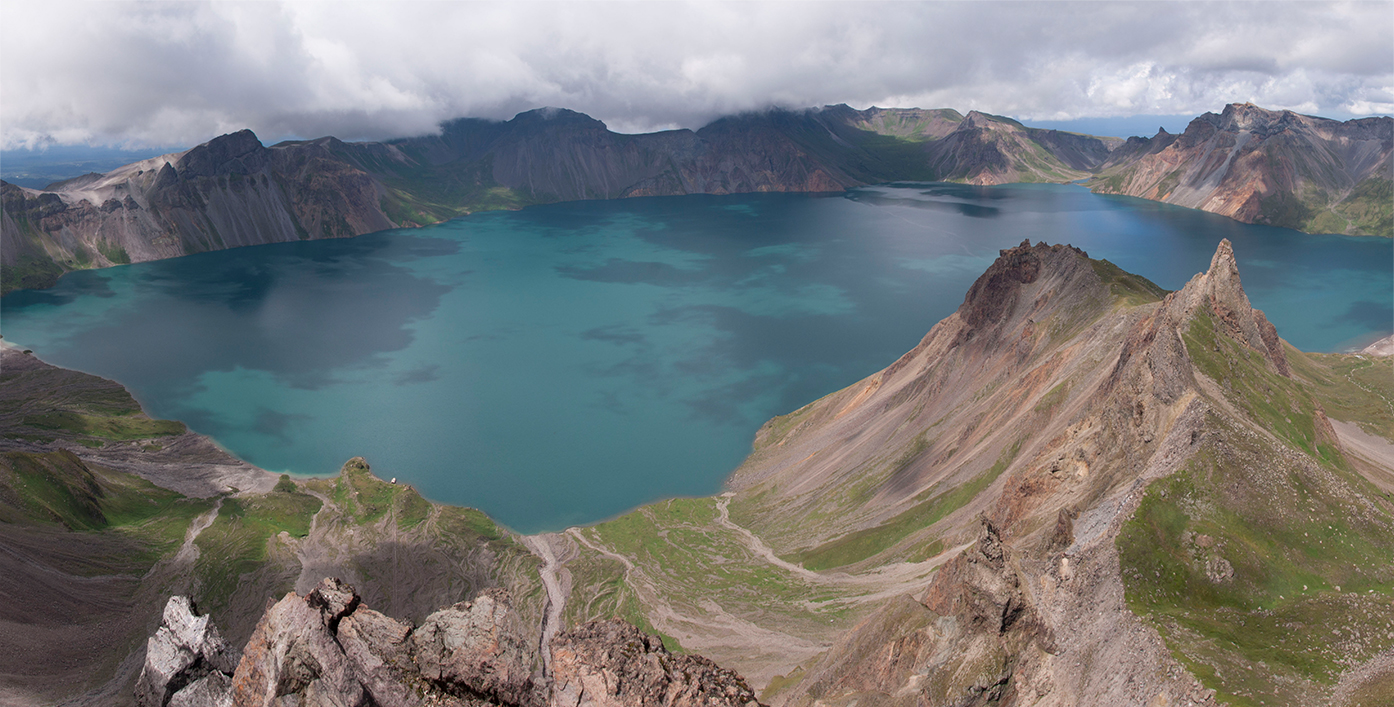 Baekdusan Mountain is a serene and divine place where the spirits of South and North Korea meet.
Baekdusan Mountain is a serene and divine place where the spirits of South and North Korea meet.Influences of the Baekdu Daeganfrom North Korea
When I started travelling to North Korea to explore the mountains of the Baekdu Daegan mountain range there, I was surprised to find that they shared the concept of “one people, one mountain,” too. They recognized the Baekdu Daegan, and that despite Korea’s political division, the mountain spine of the Baekdu Daegan remained intact. It was a roof beam that held together the peninsula. It dawned on me that the people of the North weren’t unlike their brothers and sisters in the South. Sure, there were political differences, but the characteristics and mannerisms were the same. Seventy years of division and foreign interference is not long enough to rid a people of their inborn traits acquired over thousands of years.
I started holding photo exhibitions of my work showing the mountains of the Baekdu Daegan, from both the North and the South. I did this in Seoul, Pyeongyang and Kyoto. People would tell me that my work was more than just an exhibition; that it was a way to bring together the people of Korea. It was the spine of Korea that did that.
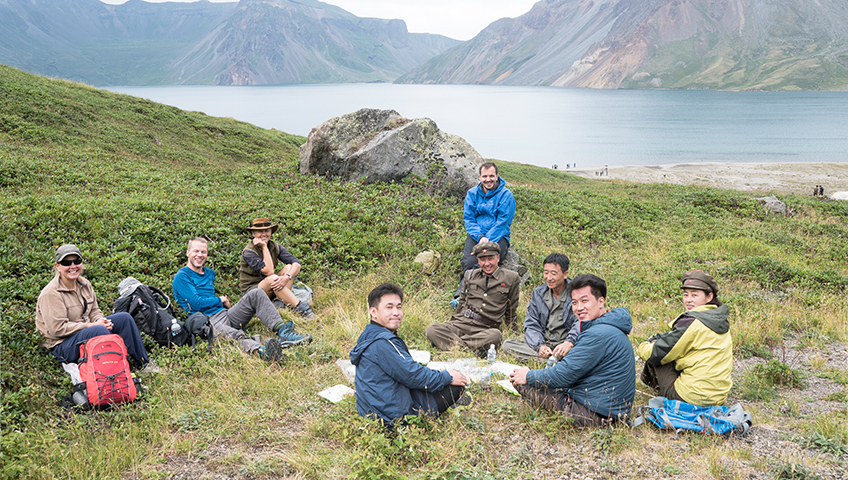 Roger Shepherd eats lunch at Choenji Lake in 2018.
Roger Shepherd eats lunch at Choenji Lake in 2018.
They also told me I was lucky to be able to travel widely around the peninsula, especially in the North. That stuck, because they were right. It was sad that I, a non-Korean, could access corners of this land and that they, Koreans, the owners of this land, could not. It angered me slightly, to be honest, especially knowing that it was foreigners that divided this land in the first place.
That’s when my work began to head in a new direction. However, it needed a political shake-up for that to start, and luckily that’s what happened.
At the PyeongChang 2018 Olympic and Paralympic Winter Games, newly-elected President Moon Jae-in acknowledged in his speech that Korea was one nation bound together by the Baekdu Daegan. Then, at the April 27 Inter-Korean Summit, Chairman Kim Jong Un and President Moon Jae-in planted a native pine tree in commemoration of their historic meeting. They symbolically mixed soil from both Baekdusan and Hallasan mountains when planting the tree. The Baekdu Daegan was, once again, becoming a symbol of a unified Korea. Korea’s kinship with its mountains was reemerging.
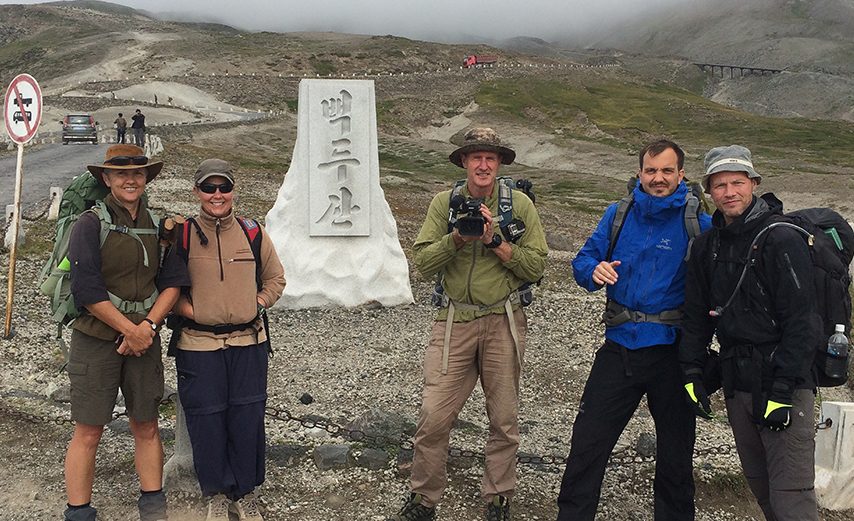 Roger Shepherd and his hiking crew at the start point to Baekdusan Plateau trekking expedition.
Roger Shepherd and his hiking crew at the start point to Baekdusan Plateau trekking expedition.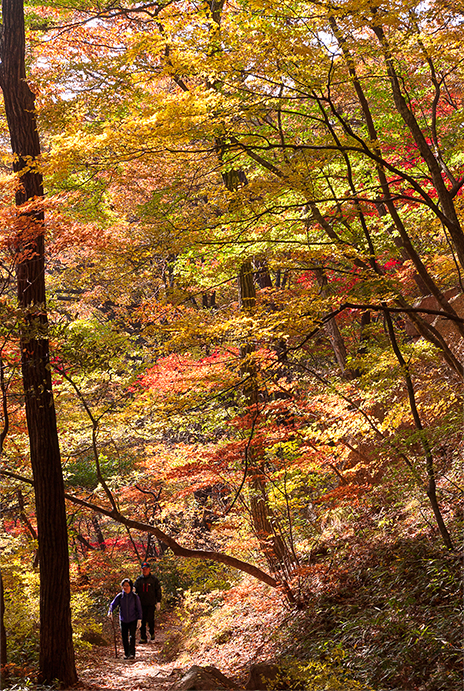 Fantastic autumn colors of Songnisan Mountain in Chungbukdo province. It is the hope of all that people from the North can travel to the South to see the beautiful mountains.
Fantastic autumn colors of Songnisan Mountain in Chungbukdo province. It is the hope of all that people from the North can travel to the South to see the beautiful mountains.Blazing Trails for Korean Reunification
In August 2018, I conducted for the first time a one-week trek of the magnificent Baekdu highland plateau in North Korea. A team of five non-Koreans trekked across the plateau. Each day, with our North Korean hosts, we pitched tents, cooked together, ate together, drank together, sang campfire songs together, and got to know each other better.
I saw an incredible cultural landscape waiting to be opened up to the world. I’m not talking about mass commercialization or tourism. The Baekdu Plateau is a scared area to the people of North Korea. It’s where the forefathers of Korea hid from the raiding Japanese imperialists. They infiltrated in and out of Manchuria to ambush them, spread propaganda about how to defeat them, and urged the populace never to give up the fight for Korean independence. The plateau is a scared area of revolution.
What I saw was an opportunity to bring the people of Korea together. Samjiyeon-gun County, the area that serves Baekdusan Mountain, is under massive reconstruction for tourism. The small ski town is receiving new infrastructure, new hotels and a new rail line that can bring guests all the way from Pyeongyang. It also has an airport. Construction will be complete by 2020.
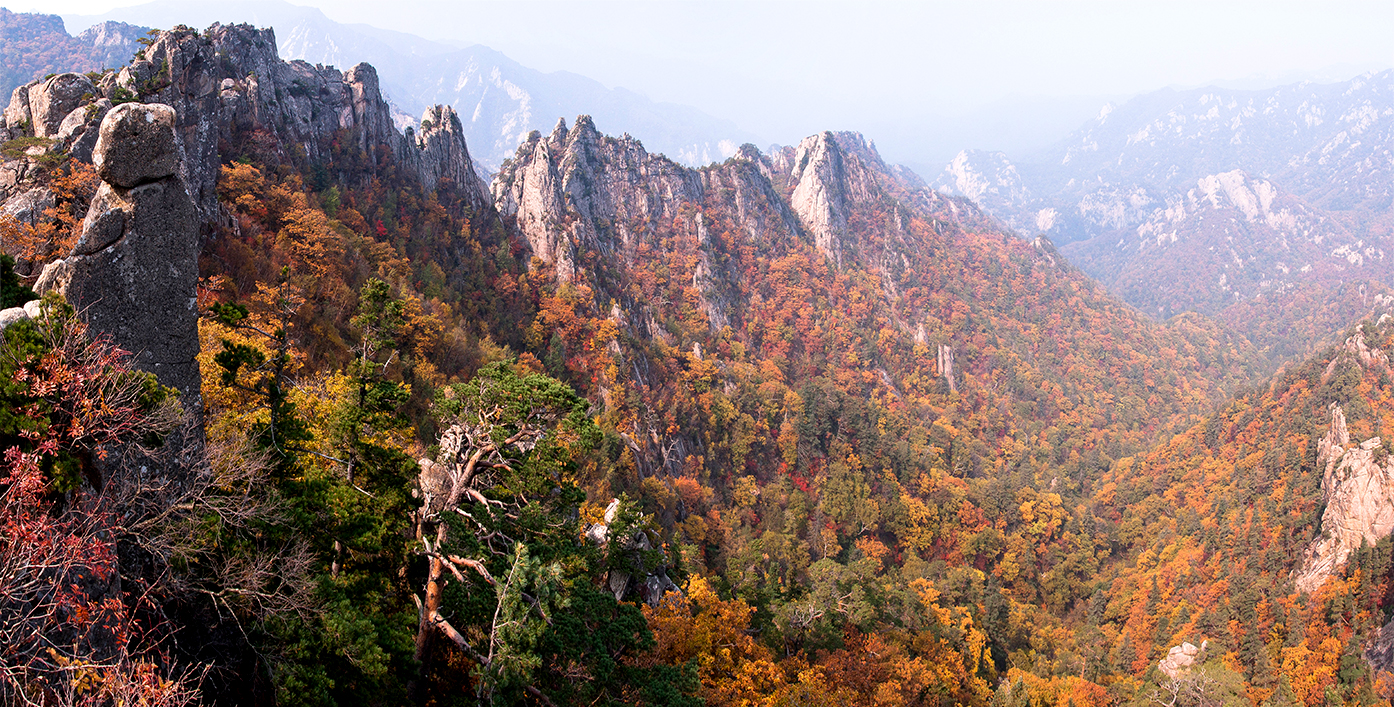 Seoraksan Mountain in fall with its beautiful reddish golden hue
Seoraksan Mountain in fall with its beautiful reddish golden hue
I want to develop and open up a new trail network on the untouched Baekdu Plateau on which we have trekked. It’s important to have designated trails to keep hikers off the delicate plateau grasslands that host millions of wildflowers and herbs. The trails could be signposted and mapped. The circuit would need shelters. It rains a lot up there, too, so sturdy, dry, but simple, log cabins, made from native larch pine, would be perfect. Each site could have a grassy patch for tents, a freshwater supply and, of course, toilets. Trekkers could pay for an allocated number of permits issued each year to walk the pristine alpine plateau. The permits could help to maintain the ecological area and to pay local guides. Hikers, of course, would need to carry out their own garbage. This is a sustainable tourism idea.
However, that’s not all it is. It’s also an opportunity for the people of South Korea to come and see their sacred Baekdusan Mountain and its glorious undulating highlands from the Korean side.
If the message from Kim Jong Un and Moon Jae-in - that the Baekdu Daegan is the spine that connects the Korean people - stays alive, and if the two Koreas can stay on track in terms of peaceful cooperation and mutual exchange, then when Samjiyeon-gun County opens up in 2020, I think there will be an opportunity for people everywhere, from North Korea, South Korea and elsewhere, to respectfully explore this sacred region of the Earth.
Other Articles





Love Travels Through the Strings of the Violin





Application of subscription
Sign upReaders’ Comments
GoThe event winners
Go


 October 2018
October 2018


